TRIALS & TRIBULATIONS OF THE 2016 KTM 250SXF FACTORY EDITION
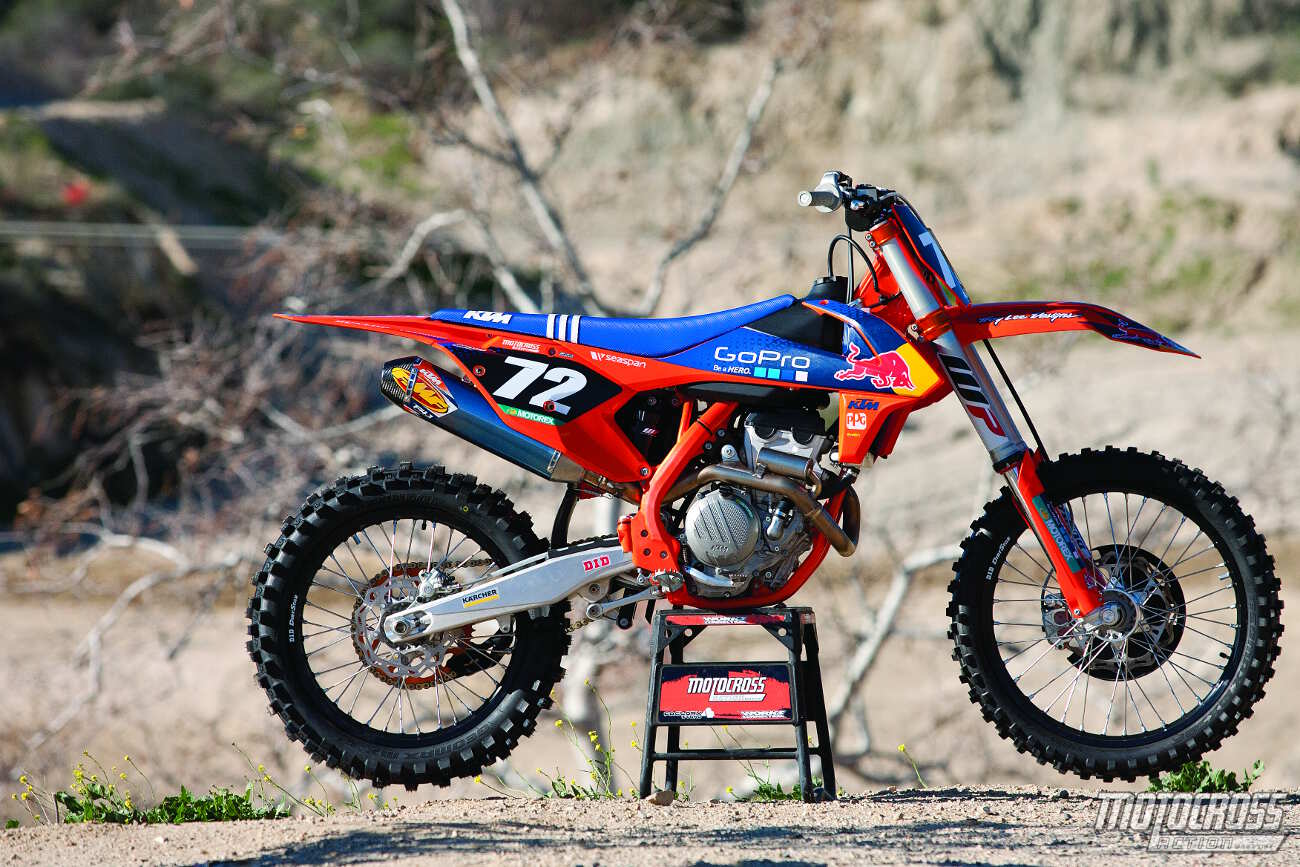
By Jody Weisel
What I’d really like is a new way to express my love/hate relationship with WP. Of course, I am really only talking about how much I hate WP, because the only thing I love about WP is the long litany of jokes that come at their expense. I find humor important when dealing with a company that has tried to do me harm every year for the past two decades. That I have lived is testimony to the human will to survive in the face of a company that is to suspension what Josef Stalin was to Russian farmers.
I have swapped, hopped, clicked and kicked my way around hundreds of laps on WP-equipped bikes with the full knowledge that Lovely Louella was standing by the side of the track rooting me on—with my life insurance policy in one hand and the phone number of the pool boy in the other.
“THE ACTUARY TABLES PLACE WP SUSPENSION ON PAR WITH RIDING AS A BACKSEATER WITH THE MEXICAN VERSION OF THE BLUE ANGELS.”
When it comes to taking risks, some guys like to skydive, wrestle gators or marry women who are 13 years younger. Not me. Strap me on a KTM with stock WP forks and shove me down Mt. Saint Helen. Thrills and chills abound. The actuary tables place WP suspension on par with riding as a backseater with the Mexican version of the Blue Angels.
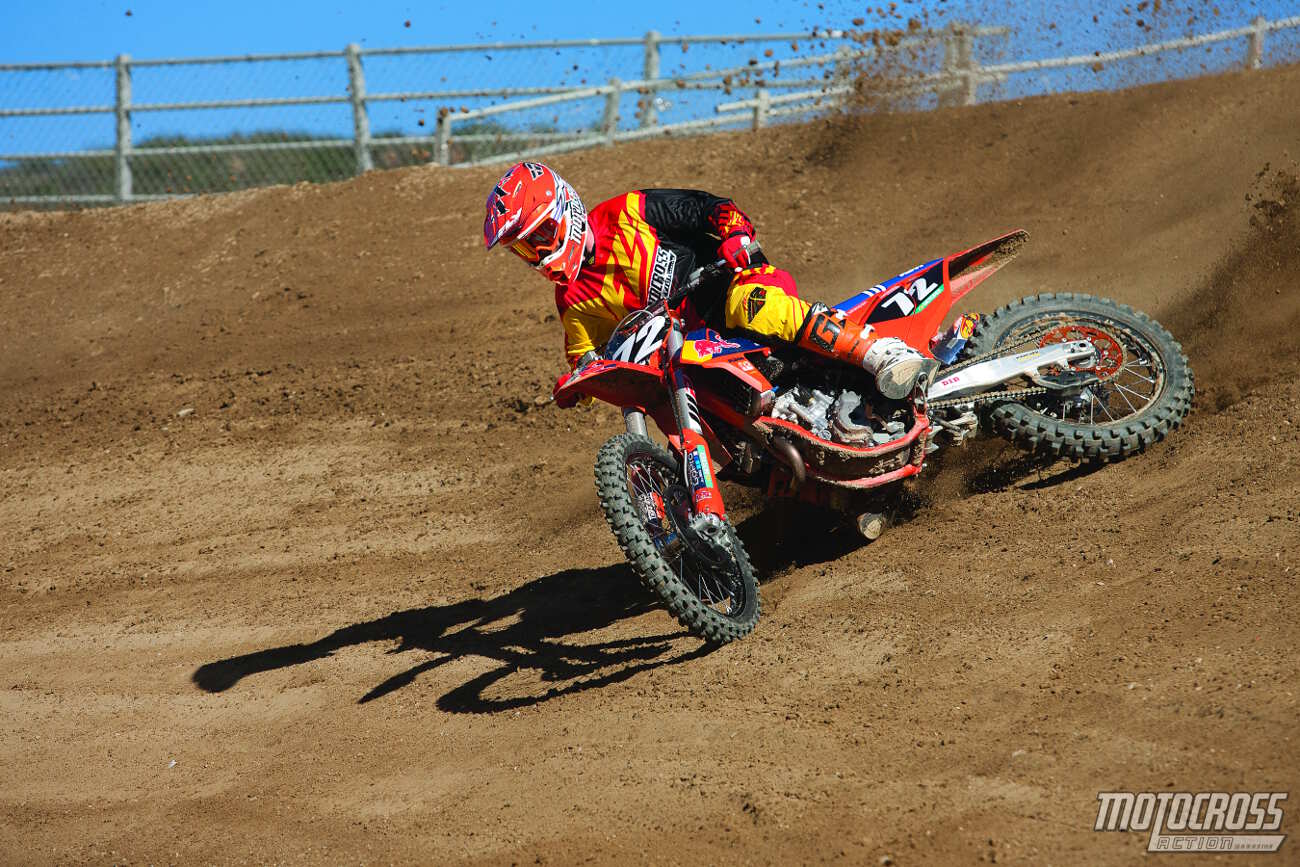
But wait; let’s analyze the contradictory factors in what I’ve said.
First, the guys at WP aren’t trying to kill me personally—they are just inept at improving my odds of making it through the whoops. If I crash, it’s because I misjudged both the conditions and my skill. But, how was I to know that the WP forks couldn’t absorb a Snickers wrapper at more than 10 miles per hour?
Second, I have voluntarily climbed aboard lots of bikes that taxed my central nervous system by missing shifts on the face of jumps, having the brakes fail on the only fifth-gear straight on the track or breaking in half at the darndest moments. We are all thrill junkies. But, where’s the thrill in hitting braking bumps with flawless Kayaba SSS suspension when you could be doing it with the descendants of Henk Thuis’ White Power forks? That’s livin’ on the edge.
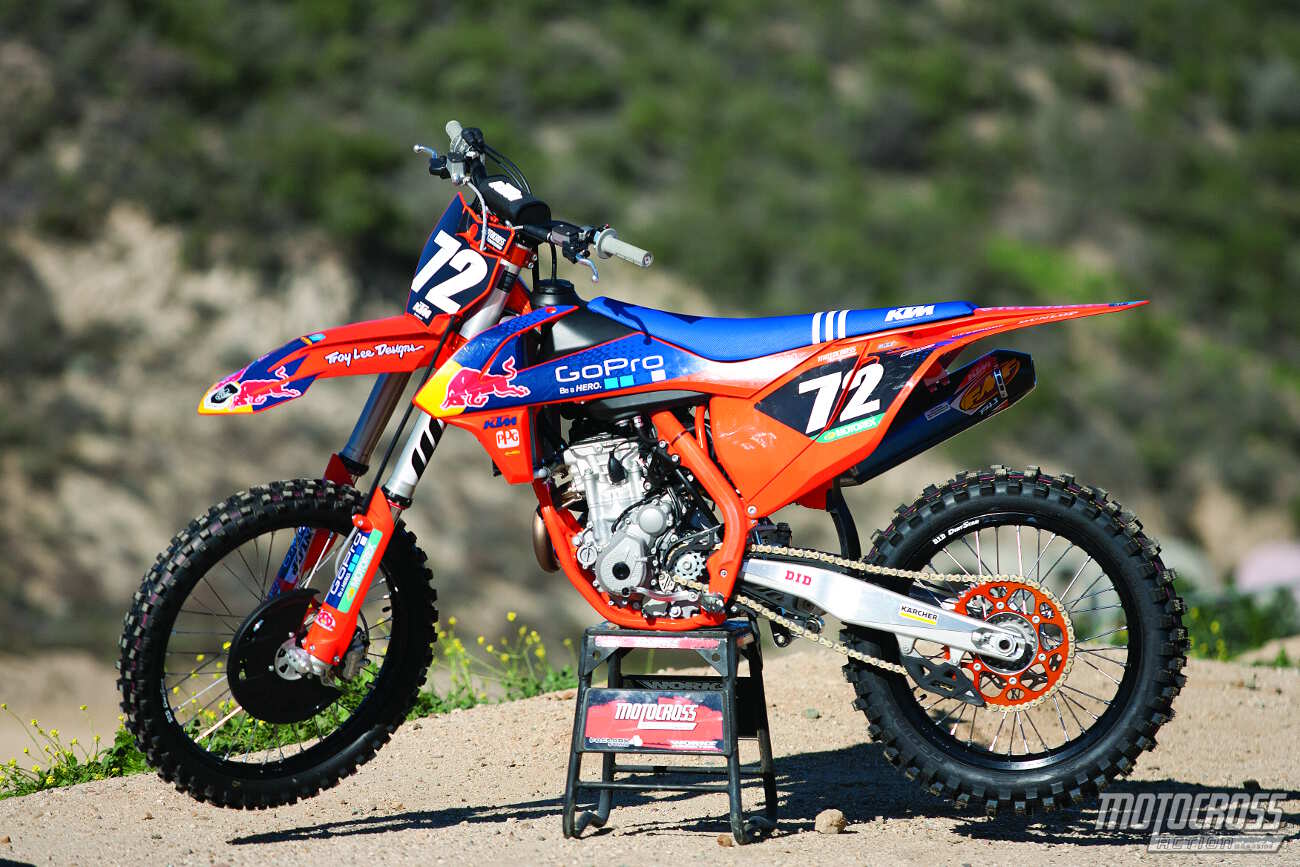
Third, let’s forget the past. I may have said less than a month ago, that “KTM’s biggest foe isn’t Honda, Yamaha, Suzuki or Kawasaki—it is WP. The ‘Big Four’ should buy shares in the publicly traded WP out of gratitude for how much they have damaged the marketability of the Austrian brand. Great engines, superb handling, awesome brakes and clean design don’t mean doodly-squat if the forks don’t work.” But, I’m willing to let bygones be bygones and forgive and forget—after all, most of the scars have long since healed.
“I KNOW, I, TOO, AM SURPRISED THAT THIS IS ACTUALLY A BIKE TEST. IT STARTED OUT MORE LIKE THE PROSECUTORIAL OPENING STATEMENT AT NUREMBERG IN NOVEMBER OF 1945.”
Which leads me to the 2016-1/2 KTM 250SXF Factory Edition. It is the stalking horse of the 2017 KTM 250SXF—which isn’t out yet, so looking at the Factory Edition is a valid indicator of what to expect. Thus, this bike test is important. I know, I, too, am surprised that this is actually a bike test. It started out more like the prosecutorial opening statement at Nuremberg in November of 1945. But, I didn’t come here to talk about the 2016-1/2 KTM 250SXF Factory Edition—well, not all of it anyway, just the one part that hard-core motocross racers would want to know about. The fork. The WP fork. The WP air fork. The WP 48mm AER fork. The fork on which so many American motocross racers are basing their hopes and dreams. Face it; if these forks don’t work any better than the previous 4CS forks, I’m just gonna go home, turn Joni Mitchell up real loud and write sonnets on scented paper, which will get published after I die during a shootout with the Bundespolizei while trying to burn down a factory in Munderfing, Austria.
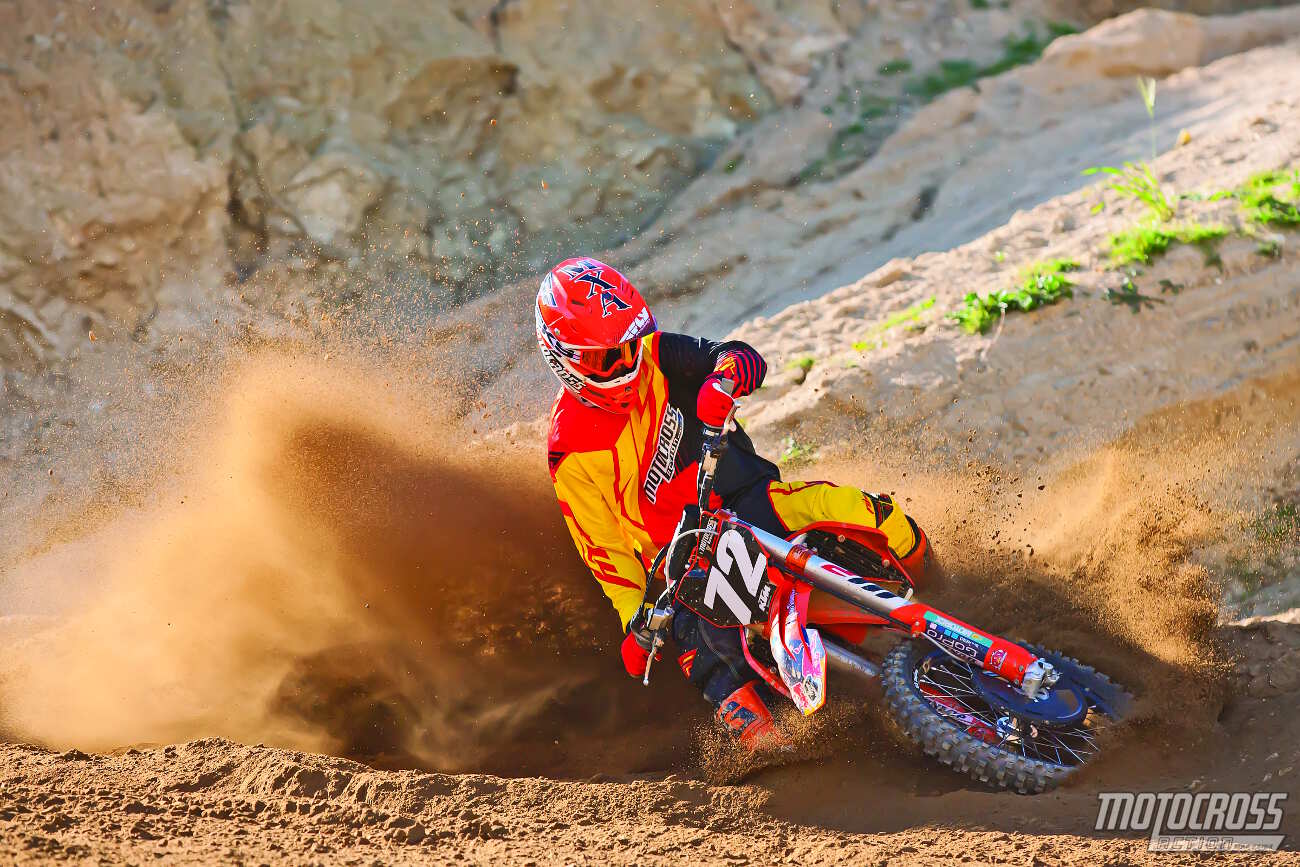
But before I get to the forks, let me get a little business out of the way—it will justify this month’s paycheck. The 2016-1/2 KTM 250SXF Factory Edition is like a girl you meet in a club at 2 a.m. Her spiked hair is frosted white. She has on blue lipstick and one too many earrings in her ears—if you think eight is too many. But, it turns out that she’s really that wallflower who sat behind you in homeroom in the ninth grade—just gussied up with stripper glitter. That is what the 2016-1/2 KTM 250SXF Factory Edition is. It’s a plain Jane 2016 KTM 250SXF that looks like it was bedazzled.
The gold triple clamps are the same as the stock Neken clamps, but with unicorn pizazz. The rims are black D.I.D. DirtStars borrowed from the Husqvarna FC250 parts shelf. The blue seat has ribs on it that are stout enough to pull your pants down. There is an FMF muffler attached to the end of the stock KTM head/mid-pipe (and without the rest of the FMF pipe, you’re better off with the stock KTM muffler). For some ill-conceived reason the gearing on the Factory Edition has been changed from 13/50 to a much taller 14/51, which is the equivalent of running a 13/47 on the current 250SXF. Did I mention that the ODI grips are gray, not black, and there is a disc guard covering the front rotor? No? Well, let me also mention that the frame, engine, clutch, tranny, bars, brakes, hubs, airbox, filter, tires, horsepower and geometry are the same as on the box-stock 250SXF. Hey, on second thought, maybe she sat behind me in geometry class instead.
What will be different on the 2017 250SXF compared to the 2016-1/2 250SXF Factory Edition. (1) KTM saved an additional half-pound on the air forks, so the 2017 model will be 3.6 pounds lighter than the 2016 model and a half-pound lighter than the 250SXF Factory Edition. (2) There is a new map switch that makes it easier to change the maps, activate launch control or access the new traction control setting. (3) The top triple clamp is stiffer than in 2016 and the handlebar clamps have the one-piece bridge moved from the bottom of the bars to the top for more torsional stiffness. (4) The rear brake pedal is 10mm longer and the rear brake pads are less aggressive to reduce grabbiness. (5) The steel head stays of 2016 have been replaced with 60 grams lighter aluminum stays. None of these changes made the Factory Edition.

Which leaves us with the one big change—the fork. The WP fork. The WP air fork. The WP 48mm AER fork. The fork on which the hopes and dreams of so…oh yeah, I said that already.
You know, it’s a shame, but a lot of people will not believe what I’m about to say. The 2016-1/2 (soon to be the 2017 KTM fork of choice) WP AER fork is really good. I don’t mean good as in “a vast improvement over last year’s fork.” I mean really good. I’m in shock that my archnemesis, who for so many years plotted to do me in, suddenly wants to live in peaceful coexistence. Are Israel and Iran next?
In truth, they are a vast improvement over any other air fork on the market. They offer more overall comfort, ease of use and adjustability than Showa TAC or KYB PSF-2 air forks. They absorb bumps with a suppleness never felt in previous air forks and don’t clank through braking bumps (although they make a strange noise when slapped down). And, unlike the typical air fork, the WP AER forks maintain decent contact with the ground—following it as opposed to resisting it. Not only do they work well, but they are the most creative air forks made. There is no playing hopscotch with three different air chambers or Tiddlywinks with a potpourri of unfathomable clickers. The WP AER fork has one Schrader valve, which translates into a single set-it-and-forget-it air pressure. The balance chamber, which controls top-out on the return stroke, has no moving parts and is foolproof and invisible. As for clickers, there is one on the top of the right fork cap and one underneath the right fork leg.
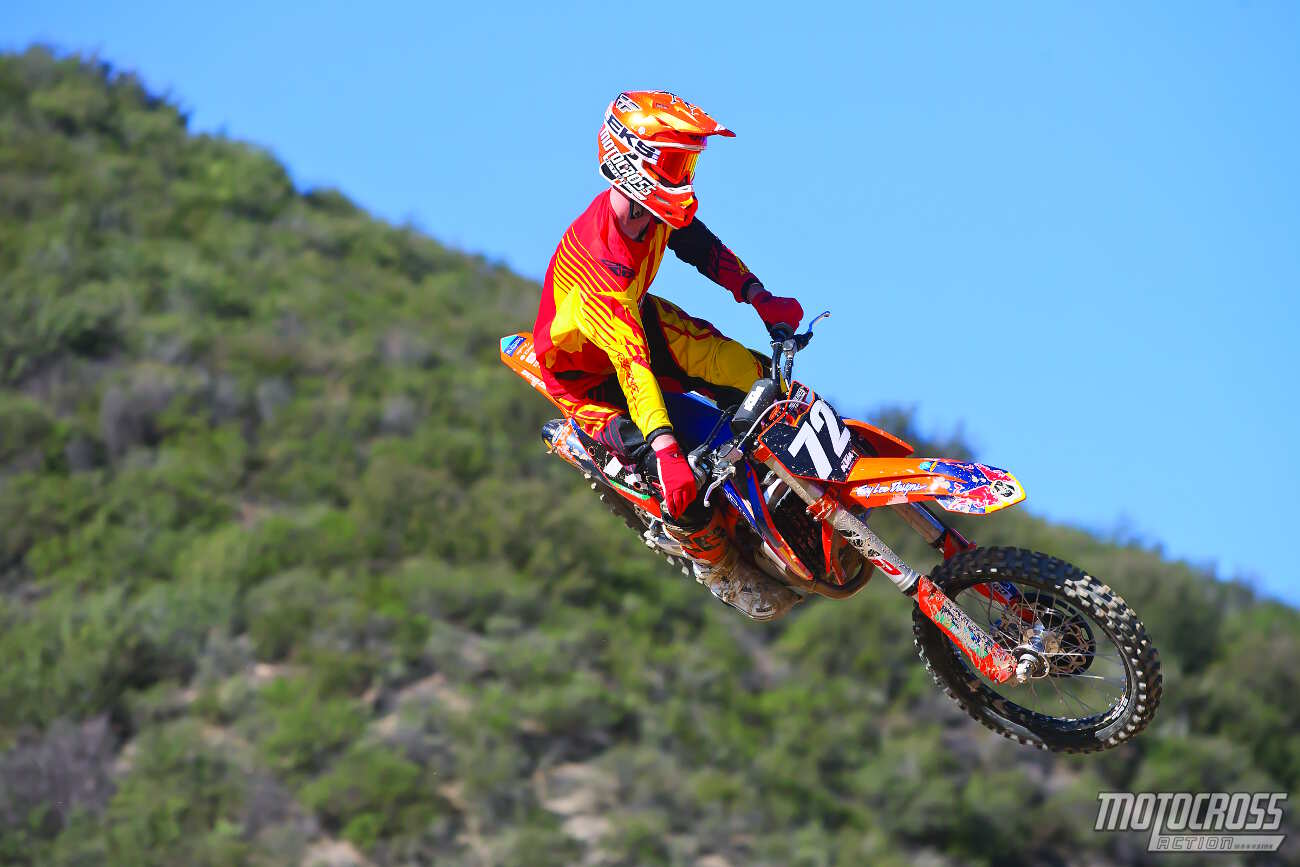
“MY SUSPICIONS WERE AROUSED DURING MY FIRST LAP ON THE WP AER FORKS. I HAD SET THEM UP TO WP’s RECOMMENDED AIR PRESSURE AND CLICKER SETTINGS—153 PSI AND 15 CLICKS OUT. SUDDENLY, I REALIZED I HAD BEEN TRICKED.”
Oh, don’t get me wrong; it wasn’t the perestroika of the Reagan/Gorbachev era. My suspicions were aroused during my first lap on the WP AER forks. I had set them to WP’s recommended air pressure and clicker settings—153 psi and 15 clicks out. Suddenly, I realized I had been tricked. These forks were as bad as ever—harsh, stiff and unfeeling. Plus, the front end rode high and my feet dangled. What next? A poison pinprick in the buttocks from a passing umbrella? As I should have expected, the Austrians’ recommendations were wrong—as always.
Once I began to play with the air pressures and clickers, I learned to like the WP AER forks—and like them a lot. The key to my happiness? I lowered the air pressure. I started at 153 psi and kept going down. They improved at 150 psi. They were much better at 148 psi. They were vastly improved at 145 psi. And, for my incremental speed, I settled on 140 psi, 20 out on compression and 12 out on rebound. As you may have surmised, that is a lot less air pressure, a lot less compression damping and more rebound than Austria thinks I should run. In back-to-back tests against a 4CS-equipped KTM 250SXF, it would be an understatement to say that the AER forks were “a vast improvement over last year’s fork.”

These forks will take away all of your insecurities about racing a KTM this coming year. It would be easy to say that WP fixed the one and only problem that KTM had, but that would be the height of insincerity, since WP has been the problem all along. As for me, death by WP has moved off my radar; however, I’m a little concerned that Chipotle is out to get me.
COMMON-SENSE SETUP TIPS FOR WP AER FORKS
These are simple forks to work with. They have one Schrader valve, one compression clicker and one rebound adjuster. They make Showa SFF TAC air forks look like a Boeing 747 instrument panel. Here are five tips to setting up your AER forks.
(1) Fork height: The WP AER forks are 953mm long (from the top of the tubes to the center of the front axle). For comparison, the 4CS forks on the current 250/450SXF are 941mm long. If you run the WP AER forks in the same place where you ran your 4CS forks, your bike will handle like a snowplow. The longer forks will slacken the head angle, raise the front of the bike and make the forks feel stiffer because of the reduced angle of attack. None of this is good. The solution? Slide the AER forks up in the clamps 12mm, plus however far up you were running the 4CS forks. For the MXA wrecking crew, that meant that we had 15mm of fork tube sticking up above the triple clamps. It might look extreme, but that just gets the long forks back where they would be if they were short.
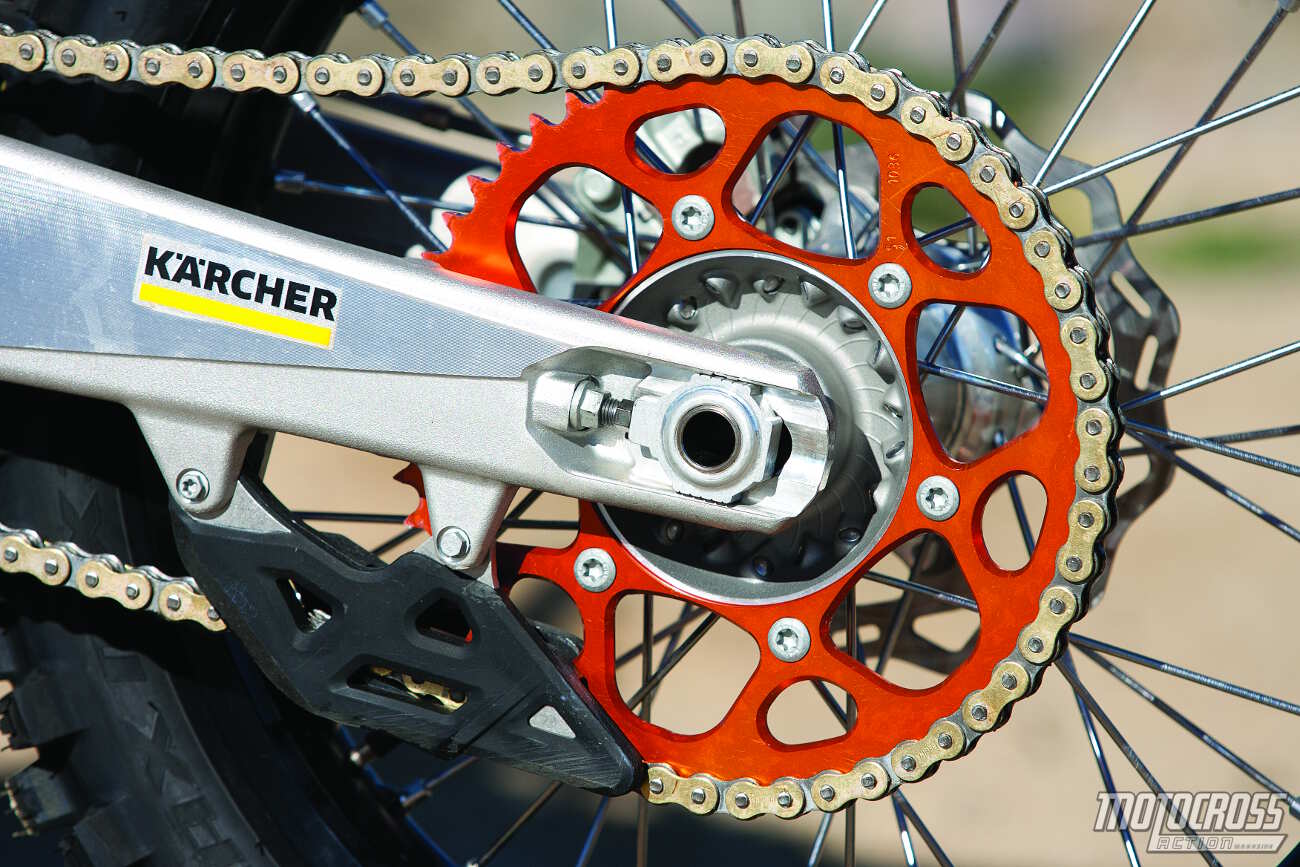
(2) Bar none. The recommended air pressure from KTM is listed in bars not psi. No problem. The pump that comes with your Factory Edition has a switch to change the digital readout from bars to psi. Back in Austria, they don’t understand that Americans do not use bars as a pressure measurement; we use pounds per square inch (psi). Bar is shorthand for barometric pressure, which as you remember from your science classes is 14.5 psi. Thus, 1 bar equals 14.5 psi, so the recommended 10.6 bar on the 250SXF is 153.7 psi. Very interesting, but not practical on this side of the Atlantic.
(3) Free air. Air pressure is free and light. The 48mm WP AER forks on the Factory Edition weigh 3.1 pounds less than the coil-spring 4CS forks. Given that the 2016 KTM 250SXF weighs 221 pounds, the 2016-1/2 Factory Edition weighs 217 pounds. Yes, we know that the math doesn’t jive with 221 minus 3, but that is because the Factory Edition comes with a 1-pound-lighter FMF muffler. When the 2017 model comes out, with a stock KTM muffler, the weight should hover below 218 pounds because the 2017 forks will be 3.6 pounds lighter.
(4) The simple setting. The recommended air pressure in the 2016-1/2 KTM 250SXF Factory Edition is 153.7 psi. Initially, MXA tried to run this pressure, and we had minor success with turning the compression out 30 or more clicks to get it to work. But, ultimately it was a lost cause. The simple solution is to lower the air pressure. For average riders—not supermen—we ended up in the 140s. You might need 135, 140, 145 or 148, but only the terminally fast are going to need 153 psi. Maybe in 2017 these number will change—because we know that the valving will change.

(5) The trick. How did we arrive at our psi setting? We put a zip-tie on the right fork leg and sent test riders out to ride. When they came back, we looked at the zip-tie. If it was 4 inches short of bottoming, we lessened the air pressure, moved the zip-tie back up the fork leg and sent them out again. We kept doing this until the zip-tie got within 1-1/2 inches of bottoming. From there we worked with the compression clicker to get the feel that the test rider wanted. And, every test rider felt that he needed to go out from the stock 15 clicks of compression and in on the rebound clickers. The best clicker numbers for a Vet Novice were 20 clicks out on compression and 12 clicks out on rebound.
(6) All was not rosy. The MXA wrecking crew was happy with the WP AER air fork. Then, on the night before a race, our AER forks went flat (while sitting in the garage). The problem was that the quad-ring sealing ring on the piston cartridge had torn and air pressure leaked to the negative side of the chamber. This pulled the forks down. Although technically not flat (because the air was still in the fork, just not on the correct side of the piston), the forks were not usable until a new quad-ring was installed. Paradoxically, MXA’s fork failure, at 15 hours, might be the best thing to occur for the 2017 KTMs because it brings the problem to light before the 2017’s roll down the assembly line. WP now has an updated quad-ring seal that will go in every 2017 AER fork.
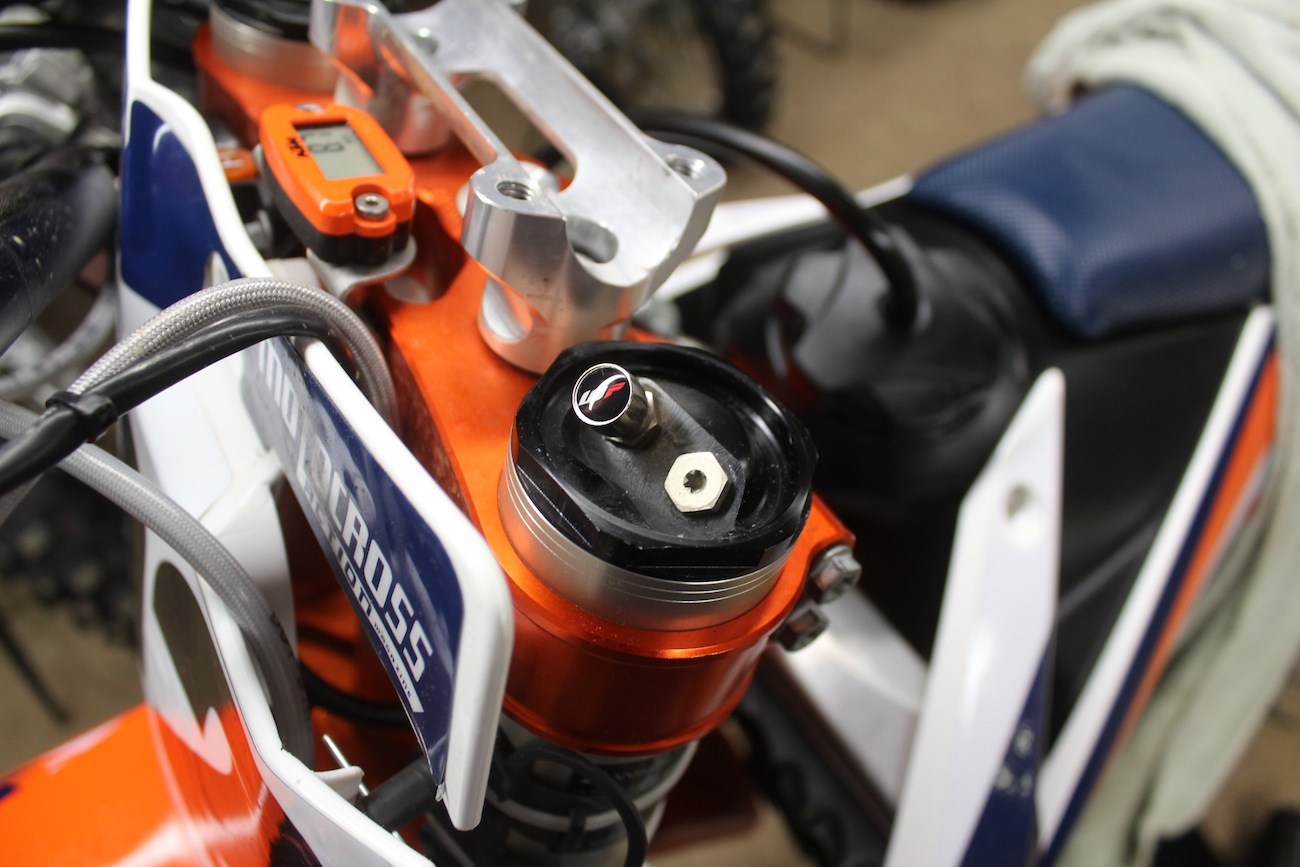
AND THERE YOU HAVE IT
To MXA’s way of thinking, the 2017 KTM 250SXF’s AER forks will be improved over the Factory Edition set-up. How so? KTM’s American test department learned a lot during the Factory Edition period. They have new valving for the 2017 production bikes and a more absorbent rear shock setting (with a lighter spring rate). For the bucks-up guys who bought 2016 Factory Editions, Thank You! You were the guinea pigs that were put to work making the soon to be introduced 2017 Katooms better.





Comments are closed.